英语论文之茶文化
茶文化英语文章
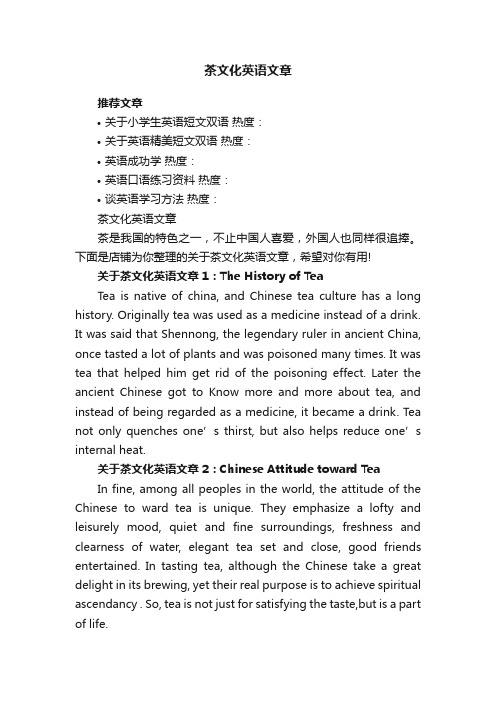
茶文化英语文章推荐文章•关于小学生英语短文双语热度:•关于英语精美短文双语热度:•英语成功学热度:•英语口语练习资料热度:•谈英语学习方法热度:茶文化英语文章茶是我国的特色之一,不止中国人喜爱,外国人也同样很追捧。
下面是店铺为你整理的关于茶文化英语文章,希望对你有用!关于茶文化英语文章1:The History of TeaTea is native of china, and Chinese tea culture has a long history. Originally tea was used as a medicine instead of a drink. It was said that Shennong, the legendary ruler in ancient China, once tasted a lot of plants and was poisoned many times. It was tea that helped him get rid of the poisoning effect. Later the ancient Chinese got to Know more and more about tea, and instead of being regarded as a medicine, it became a drink. Tea not only quenches one’s thirst, but also helps reduce one’s internal heat.关于茶文化英语文章2:Chinese Attitude toward TeaIn fine, among all peoples in the world, the attitude of the Chinese to ward tea is unique. They emphasize a lofty and leisurely mood, quiet and fine surroundings, freshness and clearness of water, elegant tea set and close, good friends entertained. In tasting tea, although the Chinese take a great delight in its brewing, yet their real purpose is to achieve spiritual ascendancy . So, tea is not just for satisfying the taste,but is a part of life.关于茶文化英语文章3是的,我爱喝茶。
茶文化英语范文
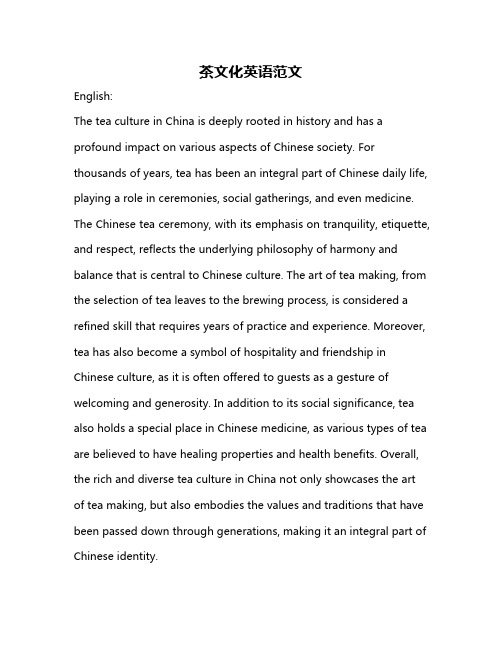
茶文化英语范文English:The tea culture in China is deeply rooted in history and has a profound impact on various aspects of Chinese society. For thousands of years, tea has been an integral part of Chinese daily life, playing a role in ceremonies, social gatherings, and even medicine. The Chinese tea ceremony, with its emphasis on tranquility, etiquette, and respect, reflects the underlying philosophy of harmony and balance that is central to Chinese culture. The art of tea making, from the selection of tea leaves to the brewing process, is considered a refined skill that requires years of practice and experience. Moreover, tea has also become a symbol of hospitality and friendship in Chinese culture, as it is often offered to guests as a gesture of welcoming and generosity. In addition to its social significance, tea also holds a special place in Chinese medicine, as various types of tea are believed to have healing properties and health benefits. Overall, the rich and diverse tea culture in China not only showcases the art of tea making, but also embodies the values and traditions that have been passed down through generations, making it an integral part of Chinese identity.中文翻译:中国的茶文化根深蒂固,对中国社会的各个方面都有深远的影响。
大学关于茶文化英语作文

大学关于茶文化英语作文在英语角中引入“茶文化”这种价值单元,对于学生来讲,都可以增长对社会交往方面“话题交谈能力”的培养,极大地拓展学生们的社会交往能力。
下面是店铺精心为你整理的大学关于茶文化英语作文,一起来看看。
大学关于茶文化英语作文1茶文化Chinese tea Chinese tea culture, tea culture. As open seven things (leading a poor You yan jiangcu tea), one of tea in ancient China is very common. Chinese tea culture and tea culture in Europe and America or Japan, a great difference. Chinese tea culture has a long history, profound, not only contains the material and cultural level, also contains a deep spiritual level.Tea by Lu Yu of the Tang Dynasty in the history of Chinese tea culture and sounded the horn. Since then, the spirit of tea permeates the court and society, into the Chinese poetry, painting, calligraphy, religion, medicine. For thousands of years China has not only accumulated a great deal about tea cultivation, production of material culture, but also accumulated rich spirit of the tea culture, which is unique to China's tea culture, a cultural study areas.中国茶,茶文化,茶文化。
茶文化英语文章

茶文化英语文章茶是我国的特色之一,不止中国人喜爱,外国人也同样很追捧。
下面是店铺为你整理的关于茶文化英语文章,希望对你有用!关于茶文化英语文章1:The History of TeaTea is native of china, and Chinese tea culture has a long history. Originally tea was used as a medicine instead of a drink. It was said that Shennong, the legendary ruler in ancient China, once tasted a lot of plants and was poisoned many times. It was tea that helped him get rid of the poisoning effect. Later the ancient Chinese got to Know more and more about tea, and instead of being regarded as a medicine, it became a drink. Tea not only quenches one’s thirst, but also helps reduce one’s internal heat.关于茶文化英语文章2:Chinese Attitude toward TeaIn fine, among all peoples in the world, the attitude of the Chinese to ward tea is unique. They emphasize a lofty and leisurely mood, quiet and fine surroundings, freshness and clearness of water, elegant tea set and close, good friends entertained. In tasting tea, although the Chinese take a great delight in its brewing, yet their real purpose is to achieve spiritual ascendancy . So, tea is not just for satisfying the taste,but is a part of life.关于茶文化英语文章3是的,我爱喝茶。
中国的茶文化英语作文800字
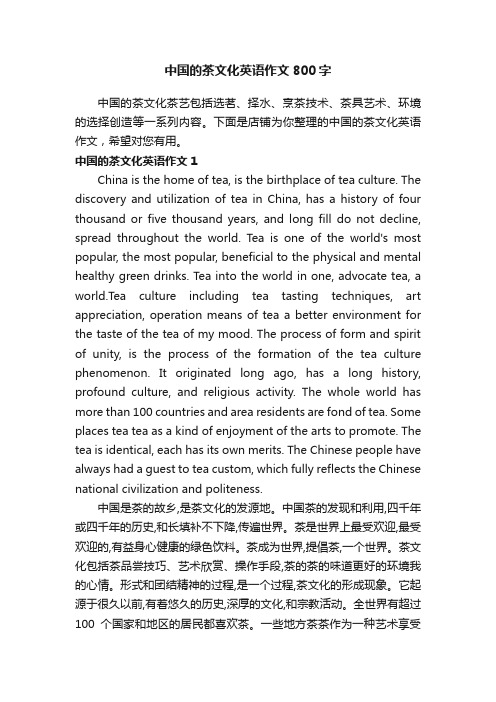
中国的茶文化英语作文800字中国的茶文化茶艺包括选茗、择水、烹茶技术、茶具艺术、环境的选择创造等一系列内容。
下面是店铺为你整理的中国的茶文化英语作文,希望对您有用。
中国的茶文化英语作文1China is the home of tea, is the birthplace of tea culture. The discovery and utilization of tea in China, has a history of four thousand or five thousand years, and long fill do not decline, spread throughout the world. Tea is one of the world's most popular, the most popular, beneficial to the physical and mental healthy green drinks. Tea into the world in one, advocate tea, a world.Tea culture including tea tasting techniques, art appreciation, operation means of tea a better environment for the taste of the tea of my mood. The process of form and spirit of unity, is the process of the formation of the tea culture phenomenon. It originated long ago, has a long history, profound culture, and religious activity. The whole world has more than 100 countries and area residents are fond of tea. Some places tea tea as a kind of enjoyment of the arts to promote. The tea is identical, each has its own merits. The Chinese people have always had a guest to tea custom, which fully reflects the Chinese national civilization and politeness.中国是茶的故乡,是茶文化的发源地。
英文作文茶文化附中文翻译
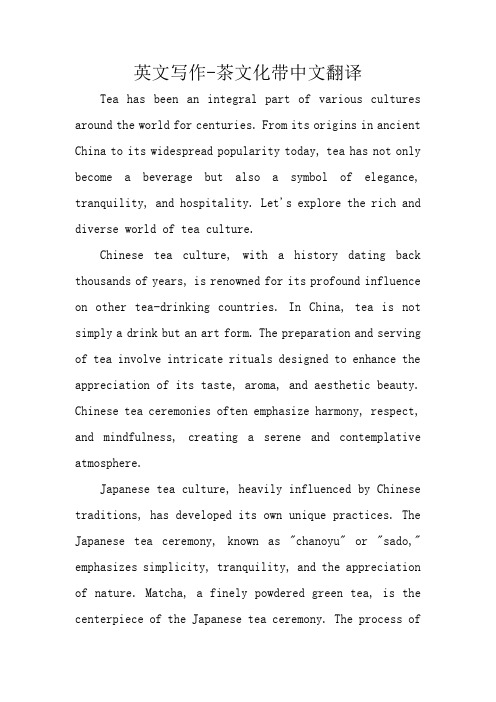
英文写作-茶文化带中文翻译Tea has been an integral part of various cultures around the world for centuries. From its origins in ancient China to its widespread popularity today, tea has not only become a beverage but also a symbol of elegance, tranquility, and hospitality. Let's explore the rich and diverse world of tea culture.Chinese tea culture, with a history dating back thousands of years, is renowned for its profound influence on other tea-drinking countries. In China, tea is not simply a drink but an art form. The preparation and serving of tea involve intricate rituals designed to enhance the appreciation of its taste, aroma, and aesthetic beauty. Chinese tea ceremonies often emphasize harmony, respect, and mindfulness, creating a serene and contemplative atmosphere.Japanese tea culture, heavily influenced by Chinese traditions, has developed its own unique practices. The Japanese tea ceremony, known as "chanoyu" or "sado," emphasizes simplicity, tranquility, and the appreciation of nature. Matcha, a finely powdered green tea, is the centerpiece of the Japanese tea ceremony. The process ofpreparing and serving matcha involves precise movements and gestures, showcasing the beauty of minimalism and attention to detail.In India, tea holds a significant cultural and social importance. Masala chai, a spiced tea blend, is a popular choice in Indian households. Tea is not only enjoyed as a refreshing beverage but also serves as a catalyst for social gatherings and discussions. The concept of "chai pe charcha," meaning "tea and conversation," reflects the role of tea as a facilitator of connections and conversations among people.Tea culture is not limited to East Asia and India. In the United Kingdom, the tradition of afternoon tea holds a special place. It is a cherished ritual that typically involves tea served with scones, finger sandwiches, and pastries. The British take pride in their tea etiquette, with proper teapot pouring techniques and the use of fine china.No matter where tea culture is embraced, it promotes a sense of relaxation, mindfulness, and social interaction. Whether it is a formal ceremony or a casual gathering with friends, tea offers a moment of pause in our busy lives,allowing us to appreciate the simple pleasures and connect with others.中文翻译为:茶在世界各地的文化中已经有数百年的历史,它不仅成为一种饮料,更是优雅、宁静和热情待客的象征。
茶文化英语作文

茶文化英语作文英文回答:Tea culture is a complex and multifaceted phenomenon that has developed over centuries and across different cultures. It encompasses the cultivation, processing, preparation, and consumption of tea, as well as the rituals and traditions associated with it.In China, tea has been cultivated for over 5,000 years and is considered a national beverage. The Chinese tea ceremony is a highly ritualized process that involves the careful preparation and serving of tea. In Japan, tea was introduced in the 9th century and has since become an integral part of Japanese culture. The Japanese tea ceremony, known as chanoyu, is a refined and meditative practice that emphasizes the harmony between nature, art, and humanity.In Britain, tea was introduced in the 17th century andquickly became a popular beverage. The British tea ceremony is less formal than its Chinese and Japanese counterparts, but it still involves the use of specific teaware and the adherence to certain etiquette.Today, tea is enjoyed all over the world and has become a symbol of hospitality, friendship, and relaxation. The global tea industry is vast and complex, with different countries producing and consuming different types of tea.中文回答:茶文化是一个复杂且多方面的现象,几个世纪以来在不同的文化中不断发展。
茶文化的英文作文
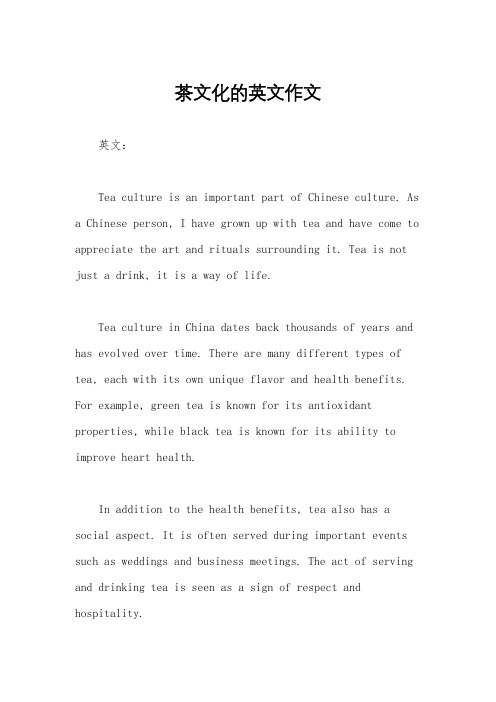
茶文化的英文作文英文:Tea culture is an important part of Chinese culture. As a Chinese person, I have grown up with tea and have come to appreciate the art and rituals surrounding it. Tea is not just a drink, it is a way of life.Tea culture in China dates back thousands of years and has evolved over time. There are many different types of tea, each with its own unique flavor and health benefits. For example, green tea is known for its antioxidant properties, while black tea is known for its ability to improve heart health.In addition to the health benefits, tea also has a social aspect. It is often served during important events such as weddings and business meetings. The act of serving and drinking tea is seen as a sign of respect and hospitality.One of the most famous tea ceremonies in China is the Gongfu tea ceremony. It involves using small clay teapots and cups, and requires a lot of skill and practice to master. The ceremony is not just about drinking tea, but also about appreciating the beauty of the teaware and the art of brewing tea.Tea culture has also spread beyond China and has become popular in other countries. For example, in Japan, the tea ceremony is an important part of their culture. In England, afternoon tea is a popular tradition that involves drinking tea and eating small sandwiches and pastries.中文:茶文化是中国文化的重要组成部分。
关于茶文化的英文作文
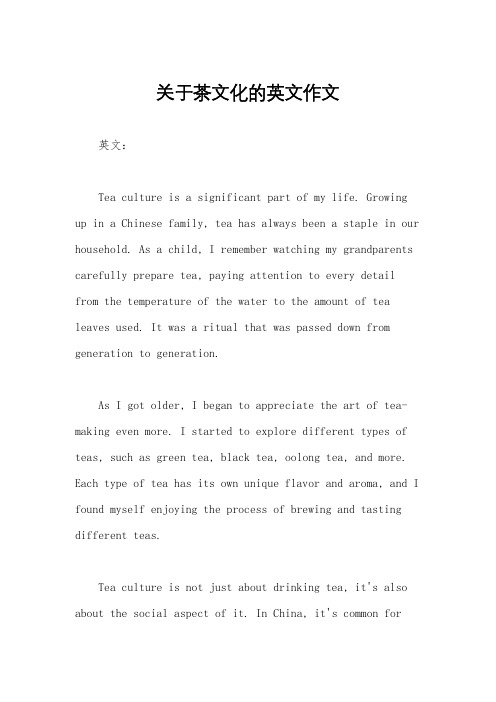
关于茶文化的英文作文英文:Tea culture is a significant part of my life. Growing up in a Chinese family, tea has always been a staple in our household. As a child, I remember watching my grandparents carefully prepare tea, paying attention to every detail from the temperature of the water to the amount of tea leaves used. It was a ritual that was passed down from generation to generation.As I got older, I began to appreciate the art of tea-making even more. I started to explore different types of teas, such as green tea, black tea, oolong tea, and more. Each type of tea has its own unique flavor and aroma, and I found myself enjoying the process of brewing and tasting different teas.Tea culture is not just about drinking tea, it's also about the social aspect of it. In China, it's common forpeople to gather and drink tea together, whether it's with family, friends, or colleagues. It's a way to connect with others and share a moment of relaxation and conversation.In addition to its social aspect, tea culture also has health benefits. Many types of tea are known for their medicinal properties, such as boosting the immune system, aiding digestion, and reducing stress.Overall, tea culture is a beautiful and meaningful part of my life. It's a way to connect with my heritage, appreciate the art of tea-making, and share moments of relaxation and conversation with others.中文:茶文化是我生活中重要的一部分。
高考英语作文茶文化

高考英语作文之茶文化1Tea culture has a profound and long history in China, embodying not only a drink but also a reflection of wisdom and art. China boasts a wide variety of teas, among which green tea, black tea, and oolong tea are highly favored. Green tea is renowned for its fresh and delicate flavor, rich in antioxidants that are beneficial for health. Black tea, on the other hand, has a robust and mellow taste, often used in blends and enjoyed with milk or sugar. Oolong tea stands out with its unique aroma and complex flavor profile.The traditional way of making tea in China is an elaborate process. Fine tea leaves are carefully selected and placed in a specially designed tea pot. Hot water of the appropriate temperature is poured gently over the leaves, allowing them to unfurl and release their essence. The infusion time is crucial to achieving the perfect flavor.The choice of tea sets also plays a significant role. Delicate porcelain cups or clay pots are commonly used, each adding to the aesthetic appeal and enhancing the tea-drinking experience.In conclusion, Chinese tea culture is a treasure trove of traditions and craftsmanship. It brings people not only the pleasure of taste but also a spiritual enjoyment and a connection to history and culture.2Tea culture has been an integral part of Chinese life for centuries, and its charm is truly remarkable. In China, tea plays a significant role in social gatherings. When friends come together, they often enjoy a cup of fragrant tea while engaging in heartfelt conversations. This not only provides a pleasant atmosphere but also deepens the bonds between them.The traditional customs and etiquette associated with tea are equally fascinating. For instance, when serving tea to guests, it is important to show respect by using proper gestures and a polite manner. The order of serving and the way the tea is presented all carry symbolic meanings.Moreover, the types of tea available in China are numerous, each with its own unique characteristics and flavors. Green tea, black tea, oolong tea, and others all have their devoted followers. The process of making tea is also an art form, requiring precise control of water temperature and steeping time to bring out the best taste.In conclusion, Chinese tea culture is not just about drinking a beverage; it is a reflection of our heritage, a symbol of hospitality, and a means of fostering connections. It is a precious gem that continues to shine in the rich tapestry of Chinese traditions.3Tea culture has been an integral part of Chinese life for centuries,exerting a profound and far-reaching influence. Tea is not merely a beverage; it is a symbol of tranquility and a source of relaxation. When people are stressed and exhausted after a long day of work or study, a cup of fragrant tea can soothe their nerves and alleviate their fatigue. The act of brewing and sipping tea becomes a moment of respite, allowing them to forget the hustle and bustle of daily life and find inner peace.Furthermore, tea plays a significant role in maintaining good health. It is rich in various beneficial substances that contribute to our well-being. Regular consumption of tea can enhance our immune system, improve digestion, and prevent certain diseases. Many people incorporate tea into their daily routine as a natural and healthy choice.In family life, tea holds a special place. Gatherings around the tea table provide an opportunity for family members to come together, share stories, and strengthen their bonds. It is a time when generations communicate, passing down traditions and values. The aroma of tea fills the room, creating a warm and harmonious atmosphere.In conclusion, tea culture has deeply permeated every aspect of Chinese life. It brings comfort, health, and unity to people, making it an indispensable part of our heritage and identity.4Tea culture in China has a long and illustrious history that has undergone significant changes and developments over the centuries. Inancient times, tea was regarded as a precious commodity and was mainly consumed by the nobility and scholars. It was not only a beverage but also a symbol of refinement and elegance.As time went by, tea gradually became more accessible to the common people. During the Tang Dynasty, a famous figure named Lu Yu wrote the "Classic of Tea," which comprehensively documented the cultivation, processing, and drinking methods of tea. This work greatly promoted the spread and development of tea culture.In the Song Dynasty, tea ceremonies became highly elaborate and ritualistic. People paid great attention to the quality and variety of tea, as well as the art of brewing and presenting it.In modern times, tea has become an integral part of daily life for many Chinese people. The tea industry has also seen significant technological advancements, from improved cultivation techniques to innovative processing methods.Today, Chinese tea is renowned worldwide for its diverse varieties and rich cultural connotations. It not only quenches thirst but also serves as a medium for communication and cultural exchange. The evolution of tea culture reflects the changing social and cultural landscapes of China throughout history, and it continues to thrive and evolve, bringing joy and well-being to people's lives.5Tea culture, a profound and enchanting aspect of human civilization, holds significant value in international communication. The spread and popularity of Chinese tea around the world are remarkable. For instance, in the United Kingdom, the afternoon tea tradition has incorporated elements of Chinese tea, creating a unique blend of cultures. The delicate flavors and health benefits of Chinese tea have captured the hearts of people from various nations.Not only has Chinese tea gained popularity, but the exchange and integration of tea cultures among different countries have also flourished. In Japan, the tea ceremony is an exquisite art form that emphasizes harmony and tranquility. When it meets the diverse expressions of tea culture from other countries, a beautiful symphony of cultural diversity emerges.The value of tea culture in international communication lies not only in the sharing of beverages but also in the transmission of values and aesthetics. It promotes mutual understanding and appreciation among different nations. Through the exchange of tea culture, we can learn about the customs, philosophies, and ways of life of other countries. This interaction enriches our global perspective and builds bridges of friendship and cooperation.In conclusion, tea culture serves as a gentle and inviting ambassador,facilitating communication and connection across the boundaries of nations. It is a testament to the power of shared experiences and the beauty of cultural exchange.。
茶文化英文介绍作文

茶文化英文介绍作文英文:Tea culture is an important part of Chinese culture. As a Chinese person, I grew up drinking tea and learning about its rich history and significance. Tea is not just a beverage, but a way of life.Tea has been a part of Chinese culture for thousands of years. It was originally used for medicinal purposes, but eventually became a popular beverage. Today, there are many different types of tea, each with its own unique flavor and health benefits.One of the most important aspects of tea culture is the tea ceremony. This is a formal and ritualistic way of preparing and serving tea. It is often used for special occasions, such as weddings or important meetings. The tea ceremony involves a specific set of movements and actions, and is meant to promote mindfulness and tranquility.Another important aspect of tea culture is the social aspect. Drinking tea is often done in a social setting, with friends or family. It is a way to bond and connect with others, and is often accompanied by snacks or small dishes.In addition to its cultural significance, tea also has many health benefits. It is rich in antioxidants and has been shown to reduce the risk of heart disease and certain types of cancer. It can also improve digestion and promote relaxation.Overall, tea culture is an important part of Chinese culture and has many benefits. Whether enjoyed for its taste or its health benefits, tea is a beverage that has stood the test of time.中文:茶文化是中国文化的重要组成部分。
茶文化的英文作文4篇
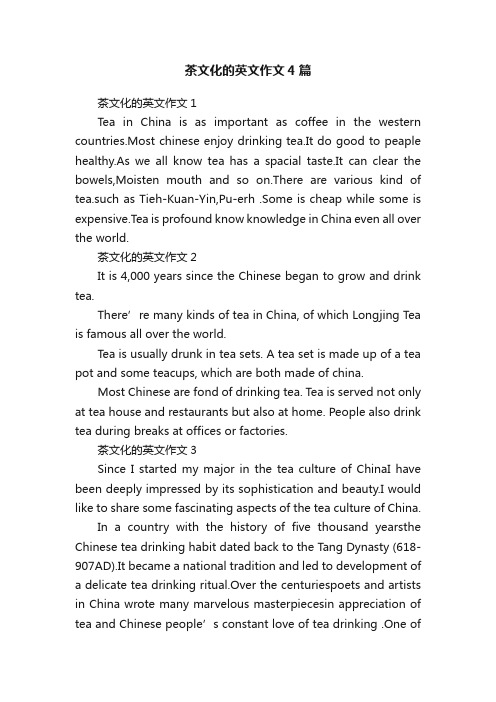
茶文化的英文作文4篇茶文化的英文作文1Tea in China is as important as coffee in the western countries.Most chinese enjoy drinking tea.It do good to peaple healthy.As we all know tea has a spacial taste.It can clear the bowels,Moisten mouth and so on.There are various kind of tea.such as Tieh-Kuan-Yin,Pu-erh .Some is cheap while some is expensive.Tea is profound know knowledge in China even all over the world.茶文化的英文作文2It is 4,000 years since the Chinese began to grow and drink tea.There’re many kinds of tea in China, of which Longjing Tea is famous all over the world.Tea is usually drunk in tea sets. A tea set is made up of a tea pot and some teacups, which are both made of china.Most Chinese are fond of drinking tea. Tea is served not only at tea house and restaurants but also at home. People also drink tea during breaks at offices or factories.茶文化的英文作文3Since I started my major in the tea culture of ChinaI have been deeply impressed by its sophistication and beauty.I would like to share some fascinating aspects of the tea culture of China.In a country with the history of five thousand yearsthe Chinese tea drinking habit dated back to the Tang Dynasty (618-907AD).It became a national tradition and led to development of a delicate tea drinking ritual.Over the centuriespoets and artists in China wrote many marvelous masterpiecesin appreciation of tea and Chinese people’s constant love of tea drinking .One ofthe best-known writers is Lu Yuwho was regarded as the “Tea Sage ” for he composed the first book on tea.In his classic bookhe detailed his studies of teasuch as the origin of teatea toolstea pickingtea cookingtea ceremony and well-known areas where tea was grown.And the valuable knowledge he recorded has laid foundation for modern tea culture development.based on ways in which tea leaves are processedthere are five distinct types of tea.They are as follow:the green teathe black teathe Wulong teathe compressed tea and the scented tea.Among themmay foreigners are familiar with the green tea.The Longjing teaof the green typehas a reputation.茶文化的英文作文4How to make a cup of teaFirst,you should check your ingredients.You should have some tea leaves and a capped teapot.Then you can make it.Let's make it together!First,put some hot water into the capped teapot.Then pour the water out of the teapot,and put some tea leaves into the teapot.Next pour some hoter water on the leaves,and then cover the capped.We should keep the teapot hot enough,so we should put some hot water on the capped.If you brew black tea,you should wait for it about 5 minutes.And you should brew green tea for about 3 minutes.At last,you can pour it into a cup and drink it!How yummy it is!Let's taste it!。
茶文化英语作文带翻译

茶文化英语作文带翻译茶文化英语作文带翻译在日复一日的学习、工作或生活中,大家对作文都再熟悉不过了吧,作文是从内部言语向外部言语的过渡,即从经过压缩的简要的、自己能明白的语言,向开展的、具有规范语法结构的、能为他人所理解的外部语言形式的转化。
你知道作文怎样写才规范吗?下面是小编为大家整理的茶文化英语作文带翻译,欢迎阅读与收藏。
Since I started my major in the tea culture of ChinaI have been deeply impressed by its sophistication and beauty.I would like to share some fascinating aspects of the tea culture of China.In a country with the history of five thousand yearsthe Chinese tea drinking habit dated back to the Tang Dynasty (618-907AD).It became a national tradition and led to development of a delicate tea drinking ritual.Over the centuriespoets and artists in China wrote many marvelous masterpiecesin appreciation of tea and Chinese people’s const ant love of tea drinking .One of the best-known writers is Lu Yuwho was regarded as the “Tea Sage ” for he composed the first book on tea.In his classic bookhe detailed his studies of teasuch as the origin of teatea toolstea pickingtea cookingtea ceremony and well-known areas where tea was grown.And the valuable knowledge he recorded has laid foundation for modern tea culture development. based on ways in which tea leaves are processedthere are five distinct types of tea.They are as follow:the green teathe black teathe Wulong teathe compressed tea and the scented tea.Among themmay foreigners are familiar with the green tea.The Longjing teaof the green typehas a reputation.自从我开始在中国的茶文化专业,我已深深感受到它的精致和美丽。
2022年茶文化的英语作文_tea culture 5篇

茶文化的英语作文_tea culture 5篇导读:关于”茶文化“的英语作文模板5篇,作文题目:tea culture。
以下是关于茶文化的八年级英语模板,每篇作文均为真题模板带翻译。
关于”茶文化“的英语作文模板5篇,作文题目:tea culture。
以下是关于茶文化的xx年级英语模板,每篇作文均为真题模板带翻译。
高分英语作文1:tea cultureChinese tea has a long history. A series of unique tea cultures, from tea cultivation, preservation, picking to processing and sampling, are mainly produced in Jiangnan to Yangtze River Basin. The climate is mild and the soil is fertile.For example, Zhejiang, Yunnan, Guizhou, Fujian and other provinces are rich in famous tea varieties such as Longjin, Wulong and Pu'er. Tieguangyin tea culture is the common characteristics of all ethnic groups in China People believe that it is not perfect not to drink tea for a day, whether in the warm southern mountains or on the frozen northern grasslands. Kungfu tea, butter tea and milk tea are all the favorite drinks for people.Both ancient and modern Chinese tend to teach poetry, prose, dance and dramahttp://wwwseechinacomcn/zhlc/zhlccontenthp3fdattend=3&isEn glish=0&fdZHLCId=.中文翻译:中国茶叶有着多年的历史,从茶树栽培、保存、采摘到加工、取样等一系列独具特色的茶文化主要产于江南至长江流域,气候温和,土壤肥沃,如浙江、云南、贵州、福建等省,盛产龙津、武隆、普洱等名茶品种,铁广银茶文化是中国各民族的共同特点,许多中国人认为,无论是在温暖的南方山区,还是在冰冻的北方草原上,一天不喝茶都是不完美的,功夫茶、酥油茶、奶茶等都是人们最爱喝的饮料,无论是古代还是现代的中国人,都倾向于对诗歌、散文、舞蹈和戏剧的阐述教学http://wwwseechinacomcn/zhlc/zhlccontenthp3fdattend=3&isEngli sh=0&fdZHLCId=。
关于茶文化英文作文
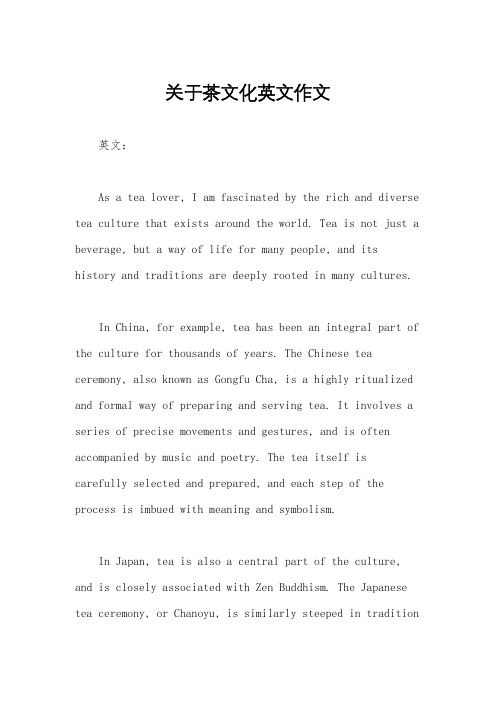
关于茶文化英文作文英文:As a tea lover, I am fascinated by the rich and diverse tea culture that exists around the world. Tea is not just a beverage, but a way of life for many people, and itshistory and traditions are deeply rooted in many cultures.In China, for example, tea has been an integral part of the culture for thousands of years. The Chinese tea ceremony, also known as Gongfu Cha, is a highly ritualized and formal way of preparing and serving tea. It involves a series of precise movements and gestures, and is often accompanied by music and poetry. The tea itself iscarefully selected and prepared, and each step of the process is imbued with meaning and symbolism.In Japan, tea is also a central part of the culture, and is closely associated with Zen Buddhism. The Japanese tea ceremony, or Chanoyu, is similarly steeped in traditionand ritual, and involves the preparation and serving of matcha, a finely ground green tea. Like Gongfu Cha, Chanoyu emphasizes mindfulness and attention to detail, and is seen as a way of cultivating inner peace and harmony.In the West, tea culture has a somewhat different character, but is no less rich or fascinating. In Britain, for example, tea is a deeply ingrained part of the national identity, and is associated with warmth, hospitality, and comfort. The British afternoon tea is a beloved tradition, and typically includes a selection of sandwiches, scones, and cakes, as well as a pot of tea served with milk and sugar.In the United States, tea culture has a more eclectic and diverse character, reflecting the country's melting pot of cultures and traditions. From Southern sweet tea to trendy matcha lattes, there is something for everyone in the American tea scene.Overall, tea culture is a testament to the power of tradition and ritual in human life. Whether we are enjoyinga cup of tea alone or with friends, we are participating in a rich and meaningful cultural heritage that spans the globe.中文:作为一位茶爱好者,我对世界各地丰富多彩的茶文化深感着迷。
茶文化的英语作文80字
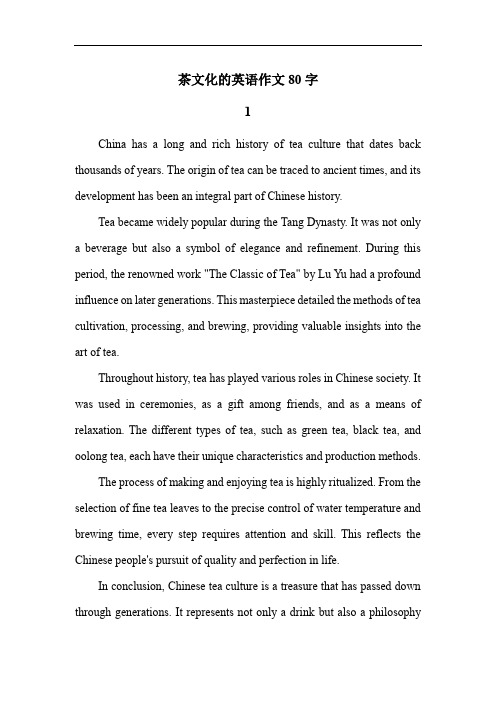
茶文化的英语作文80字1China has a long and rich history of tea culture that dates back thousands of years. The origin of tea can be traced to ancient times, and its development has been an integral part of Chinese history.Tea became widely popular during the Tang Dynasty. It was not only a beverage but also a symbol of elegance and refinement. During this period, the renowned work "The Classic of Tea" by Lu Yu had a profound influence on later generations. This masterpiece detailed the methods of tea cultivation, processing, and brewing, providing valuable insights into the art of tea.Throughout history, tea has played various roles in Chinese society. It was used in ceremonies, as a gift among friends, and as a means of relaxation. The different types of tea, such as green tea, black tea, and oolong tea, each have their unique characteristics and production methods.The process of making and enjoying tea is highly ritualized. From the selection of fine tea leaves to the precise control of water temperature and brewing time, every step requires attention and skill. This reflects the Chinese people's pursuit of quality and perfection in life.In conclusion, Chinese tea culture is a treasure that has passed down through generations. It represents not only a drink but also a philosophyand way of life, embodying the wisdom and spirit of the Chinese people.2Tea culture has been an integral part of Chinese heritage for centuries, and at the core of it lies the spirit of the tea ceremony, which encompasses the concepts of harmony, respect, purity, and tranquility.Harmony is manifested when all elements of the tea-making process come together seamlessly. The choice of fine tea leaves, the temperature of the water, and the delicate handling of the utensils all contribute to creating a harmonious experience. Respect is shown not only to the tea itself but also to the guests sharing the moment. The host prepares the tea with care and serves it with grace, while the guests receive it with appreciation.Purity is evident in the simplicity and cleanliness of the setting and the ingredients. A clutter-free space and pure water ensure that the essence of the tea is not compromised. Tranquility is felt as one immerses oneself in the ceremony, away from the hustle and bustle of daily life.I have had the privilege of attending traditional tea art performances, where I witnessed firsthand the power of these principles. The soft sounds of water boiling, the gentle aroma of the tea, and the focused movements of the tea master created an atmosphere of serenity and harmony. It was a moment of escape, a connection with nature and with oneself.In a world that is often fast-paced and chaotic, the spirit of the tea ceremony offers a haven of peace and reflection. It reminds us to slowdown, appreciate the simple pleasures, and cultivate a sense of balance and harmony within ourselves and with others.3China is renowned worldwide for its rich and diverse tea culture. Tea, an essential part of Chinese people's daily life, comes in various types, each with its unique characteristics.Green tea, for instance, is famous for its refreshing and delicate flavor. It is often produced in regions like Hangzhou, where the mild climate and fertile soil contribute to its quality. The leaves are usually tender and green, giving off a pleasant aroma when brewed.Black tea, on the other hand, is known for its mellow and robust taste. Produced mainly in areas such as Yunnan and Fujian, it undergoes a process of full oxidation, resulting in a darker color and a stronger flavor. It is often preferred by those who enjoy a bold and invigorating drink.Oolong tea stands out with its fragrant and complex bouquet. Originating from places like Guangdong and Taiwan, its production involves a partial oxidation process. The leaves are rolled and twisted, creating a unique appearance and a rich flavor profile that combines elements of both green and black tea.The differences in tea types not only lie in their flavors but also in the production methods and geographical origins. Each region imparts its own distinct characteristics to the tea it produces, making the world of Chinesetea a vast and fascinating domain to explore. The art of tea appreciation is not just about savoring the taste but also about experiencing the culture and traditions behind it.4China has a profound and long-standing tea culture that has not only endured through the ages but also witnessed remarkable innovations in modern society. The coexistence of emerging tea beverage brands and traditional tea houses is a vivid illustration of this.In the contemporary era, young people have bestowed new interpretations and understandings upon tea culture. For instance, they have embraced the concept of tea as a symbol of a healthy and refined lifestyle. Emerging tea brands have ingeniously combined modern marketing strategies with traditional tea-making techniques, offering a wide range of creative tea blends and flavors. These brands often present their products in trendy packaging, appealing to the aesthetic preferences of the younger generation.Concurrently, traditional tea houses still hold their charm and significance. They provide a serene and elegant environment where people can savor the essence of tea in a traditional manner, experiencing the profound cultural heritage. Here, the art of tea brewing and the rituals associated with it are meticulously maintained and passed on.In conclusion, the inheritance and innovation of China's tea culture inmodern society showcase its vitality and adaptability. It not only enriches people's lives but also serves as a bridge connecting the past and the future, ensuring the timeless charm of tea culture continues to thrive.5China has a profound and long-standing tea culture that has not only captivated the hearts of its own people but also spread far and wide across the international stage. The influence of Chinese tea culture is truly remarkable and can be witnessed in various aspects.In many countries, Chinese tea has become a beloved beverage. People from different nations appreciate the diverse flavors and health benefits that Chinese tea offers. For instance, green tea, with its refreshing taste and antioxidant properties, has gained popularity worldwide.The borrowing of Chinese tea culture by other countries is also evident. Some have adopted the traditional tea ceremonies and incorporated them into their own cultural practices, modifying them to suit their local customs while still respecting the essence of the original.Countless cultural exchange activities related to tea have been held abroad. These events provide a platform for people to learn about the history, production process, and cultural significance of Chinese tea. They also foster cross-cultural understanding and appreciation.The international spread of Chinese tea culture is not just about the consumption of tea but also about the sharing of values and the creation ofconnections among people of different backgrounds. It promotes a sense of harmony and tranquility, allowing individuals to slow down and savor the moment.In conclusion, the international influence of Chinese tea culture is profound and far-reaching. It has brought people together, bridging cultural gaps and enriching global cultural diversity.。
茶文化的高考英语作文

The Enchanting World of Tea CultureTea, an ancient beverage with a profound history, has been a vital part of Chinese culture for centuries. It is not merely a drink but a symbol of elegance, tranquility, and wisdom. The art of tea, known as "Chadao" in Chinese, encompasses various aspects, including tea cultivation, processing, brewing techniques, and the appreciation oftea's flavor, aroma, and visual appeal.The origins of tea culture can be traced back toancient China, where tea was initially used for medicinal purposes. Over time, it evolved into a beverage enjoyed by all classes of society. The Chinese have developed a sophisticated understanding of tea, recognizing its subtle differences in taste, aroma, and texture depending on the type of tea, its origin, and the brewing method.Tea cultivation is an intricate process that involves meticulous care and attention to detail. The choice of soil, climate, and altitude all play crucial roles in determining the quality of the tea leaves. The processing of tea leaves is equally important, as it transforms the raw leaves into the finished product, ready for brewing.The art of brewing tea is a delicate science that requires skill and patience. The water temperature, the amount of tea leaves used, and the brewing time must all be carefully controlled to extract the maximum flavor and aroma from the leaves. Each type of tea has its optimal brewing conditions, and mastering these techniques is key to enjoying tea to its fullest.But tea culture is not just about the practical aspects of brewing and drinking tea. It is also about the spirit of tranquility and reflection that tea brings. Drinking tea is often a meditative experience, one that encourages a sense of calm and peace. The slow, rhythmic movements of brewing and pouring tea can help to still the mind and promote a sense of inner harmony.Furthermore, tea culture is a social activity that brings people together. In China, it is common to gather around a tea table to chat, share stories, and enjoy the companionship of friends and family. The shared experience of preparing and drinking tea creates a bond that transcends mere conversation, fostering a deeper understanding and appreciation of each other.In conclusion, tea culture is a rich and diverse aspect of Chinese heritage that deserves to be celebrated and preserved. It is not only a beverage that satisfies the senses but a way of life that promotes tranquility, wisdom, and social bonding. As we continue to explore andappreciate the enchanting world of tea culture, we can gain a deeper understanding of the values and traditions that have shaped Chinese society for centuries.**茶文化的迷人世界**茶,这一古老饮品,承载着深厚的历史,数百年来一直是中华文化不可或缺的一部分。
英语论文之茶文化

英语论文之茶文化Tea CultureAbstractKeywords: Tea culture; Origin; Production; Drinking; CeremonyTea CultureTea is an important part of Chinese culture. The culture of tea, a kind of beverage, has formed slowly over thousands of years. It has a long history and profound cultural connotation. The production and consumption of tea are associated with a variety of cultural connotations. In this paper, we will analyze tea culture from the perspectives of origin, production, drinking, famous tea, and tea ceremony.OriginThe origin of tea culture has a long history. Tea was first used as a medicinal drink in the Western Han Dynasty. In the Three Kingdoms period, people began to use tea as a daily drink. During the Tang and Song Dynasties, tea gradually became popular and was favored by the upper classes. During the Ming and Qing Dynasties, tea became an important part of people's daily life, and tea culture began to take shape.ProductionDrinkingTea is a kind of beverage and it is very important in people’s daily life. The choice of tea varies with the occasion. Green tea is usually taken during meals, while black tea is more suitable for afternoon tea. Chinese people usually take the tea without adding sugar, milk or other condiments.Famous TeaThere are many famous teas in China. The most famous are Longjing Tea, Yulong Tea, Purple Bamboo Tea, and so on. Longjing Tea is also known as Dragon Well Tea and is one of the most famous and expensive tea in China. Yulong Tea is produced on Yulong Snow Mountain. And Purple Bamboo Tea is famous for its unique purple color.Tea CeremonyConclusionTo sum up, tea culture has a long history and is animportant part of Chinese culture. Tea culture includes the production, drinking, and famous tea, as well as the tea ceremony. It not only has strong cultural connotation, but also carries Chinese ancient civilization and national culture. It is worth exploring and promoting.。
英文作文 茶文化

英文作文茶文化英文,Tea culture is an integral part of my life. Growing up in a Chinese family, tea has always been acentral element of our daily routine. Whether it's a soothing cup of green tea to start the day or a warm pot of oolong tea to accompany a family gathering, tea has always been a symbol of comfort and togetherness for me.One of the most important aspects of tea culture is the art of brewing and serving tea. In Chinese culture, the way tea is prepared and presented is just as important as thetea itself. For example, when serving tea to elders, it is customary to hold the teapot with both hands as a sign of respect. This attention to detail and etiquette is something that has been ingrained in me since I was a child.Another aspect of tea culture that I deeply appreciateis the variety of teas available and the different health benefits they offer. For example, green tea is known forits antioxidant properties and is often touted for itsability to boost metabolism and promote weight loss. On the other hand, oolong tea is believed to aid in digestion and improve mental alertness. The knowledge of these benefits has been passed down through generations, and it's fascinating to see how different teas can have such a positive impact on our well-being.In addition to the health benefits, the act of brewing and sipping tea is also a form of mindfulness for me. Taking the time to prepare a cup of tea and savoring each sip allows me to slow down and appreciate the present moment. It's a simple yet powerful way to practice self-care and find moments of tranquility in the midst of a busy day.Overall, tea culture is not just about the beverage itself, but also about the rituals, traditions, and sense of community that it fosters. It's a way for me to connect with my heritage and find moments of peace and reflectionin a fast-paced world.中文,茶文化对我来说是生活中不可或缺的一部分。
- 1、下载文档前请自行甄别文档内容的完整性,平台不提供额外的编辑、内容补充、找答案等附加服务。
- 2、"仅部分预览"的文档,不可在线预览部分如存在完整性等问题,可反馈申请退款(可完整预览的文档不适用该条件!)。
- 3、如文档侵犯您的权益,请联系客服反馈,我们会尽快为您处理(人工客服工作时间:9:00-18:30)。
Chinese Tea CultureIntroductionChina has gone through several thousand years , Chinese culture has evolved over thousands of years. Chinese culture is broad and profound .It has a long history from ancient times, which with its unique charm to attract people from all walks of life both at home and abroad. Tea culture is one important of Chinese culture, it’s very characteristics, how to recognize and understand tea culture correctly contains a wealth of knowledge. Many countries are taking on the tea culture as an important project, which is of course a good example of Chinese culture. This essay aims to discuss the development of tea,tea review,tea drinking and Literature.1.The formation and development tea cultureA lot of books put that the discovery time of tea is time to from BC2737 to BC2697, its history can be pushed to the three emperors and five sovereigns. Huatuo, the famous doctor of Eastern Han Dynasty, his ‘eat by’ puts:" bitter tea food for a long time, benefit". Recorded the tea medical value. The Western Han Dynasty have tea production in county is named" Chaling", namely Hunan’s Chaling. To the Three Kingdoms ,Wei Dai’s" Guang Ya" is the earliest documented cake tea and preparation method of drinking: Jing Ba between leaf harvest bread cake into old, leaf, rice paste of. Tea in the form of material and penetrate into other humanities and the formation of tea culture.In the Jin Dynasty, the northern and Southern Dynasties, with the rise of literati tea, tea poetry is published, tea has been separated from the general morphology of the diet as leave cultural circle, plays a certain spiritual, social role.Luyu’s ‘The book of tea’ is the mark of the formation of tea culture in Tang Dynasty.2.Tea review2.1 sweet smellIt is known as ‘tea smell’ in the north. Tea with boiling water for five minutes, pour out the tea juice to review the bowl, smell its aroma is normal.With flowers, fruit, honey incense is loved aroma.And the smoke, rancid, mycophenolate, like, smell, often due to manufacturing processing bad or improper packaging storage.2.2 teastThe north is often called "tea" tea mellow, where fresh thick said water extract content and composition.Tea bitter, coarse old said water extract ingredients not good.Weak weak tea, said water extract content.2.3 AquaReview of the bottom of the leaf is mainly to see its colour and the old and young degree.Shoot tip and tissue fine and soft leaves the tea tenderness, said the higher.Leaf quality rough and hard thin said coarse tea old and poor growth.Bright color and texture of harmonious and consistent, that good tea technology processing.3. Tea storageTea storage purposes, is to keep the inherent color flavor and shape of tea.To achieve this we must try to keep dry sufficiently, to minimize the outside temperature, humidity, avoid contact with items with a smell, but also to make tea from compression and impact, in order to maintain its original shape, color, taste really.Home furnishing drinking tea can be placed in the double layer cover metal cans stored in a dry place, do not allow, and peculiar smell. Mix.For long-term preservation of tea, can take hot water bottle storage method, about the tea into the hot water bottle, sealed with wax, and wrapped in tape.Can also mount a double cover of the cans, tried to hold a foot, do not leave gaps.Install lid withdouble-layer cover, cover mouth sewn to use tape sealing.Tin cans coat of two layers of plastic bags, sealed bag, placed in the refrigerator freezer.It can be kept for a long time the quality of tea.4.Tea and healthTea, is the ancient Chinese beverage.With the development of modern science, the nutritional components in tea.The effect of components have been found, and through animal experiments and clinical trials to confirm its health care function.In recent years.The research results have confirmed this point, that tea is indeed beneficial to human health.5. Tea culture core valueIn the broad and profound Chinese tea culture, the tea ceremony is the core.The tea ceremony is to monasticism, the sidewalk for the purpose of tea art and tea, is tea of religious unity.Tea ceremony includes two contents: one is the preparation of tea drink, namely preparing tea skill, norms and drinking method; two is the thought connotation, namely through the tea edify sentiment, self-cultivation, the thought sublimate to philosophical, about the world life body, according to the state of the path.Also can say is in certain social condition at that time advocated moral and behavioral norms in the activity of tea.In the tea activities into philosophy, ethics, morality, "tea" to the tea as the media, through a tea for life.Tea, tea tours, tea to self-cultivation, edify sentiment, enhance friendship, learning etiquette, taste life, Zen enlightenment, reach the enjoyment of spirit and personality perfection, harmony between man and nature to the highest realm.The tea ceremony is pursuing transcendence and harmonious organic unity.Life is a reality, but also transcend.In reality people strive to overcome the defects beyond the reality, reality, from the reality, let the mind liberation and freedom, let emotion get catharsis and sublimation.Tea first pursue in Xujing Hyun concept, through intuition to life English tea: the utilitarian spiritual transcendence.Chinese tea ceremony ideology is the fusion of Confucianism, Taoism, Buddhismand other essentials.The essence of Tang Dynasty scholars and culture together, established Chinese tea culture foundation, pioneering spirit of the Chinese tea culture.Tea is not just a matter of something.More important is a spiritual enjoyment, spirit, intuition process and stresses .ConclusionIt is known to us that tea has been one of the daily necessities in China since old time. Through the above introduction about Chinese Tea, we clearly understand many respects of Chinese Tea. Chinese Tea Culture has became vey perfect after experiencing thousands of years’ development. In the modern society, Chinese Tea’s varies of categories and its efficacy make it very popular whether domestic or overseas. Specially, we can have a better understanding of Chinese Culture by drinking customs and tea brewing. Tea drinking custom shows the attitude of Chinese people to life. It indicates Chinese’characters of modest, friend and gratitude. To some extent, we can say Chinese Tea Culture is the typical representative of Chinese Culture.References1.李国庆等.《中外文化英语话题一席谈》.中国宇航.2009.2.李雪顺.《阅读中国》.高等教育.2008.3 .廖华英.《中国文化概况》.外语教学与研究.2007.4.《茶的起源及传播》. 中华美食网.20075.《论茶文化的定义、内涵与功能》 .2004-07-216.《茶.健康天地,Tea and Health》. 20107. Chinese Tea Culture [OL].[ 2011-06-17]./p-147611995013.html(语法错误,敬请见谅.)。
